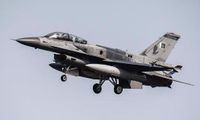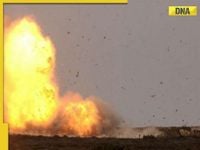In a dramatic escalation of tensions between India and Pakistan, reports have emerged that Pakistan's Airborne Warning and Control System (AWACS) was shot down within the borders of Pakistan's Punjab province. This incident, which occurred on an unspecified date, has raised concerns about the ongoing military confrontations between the two nations.
Indian media outlets are now claiming that a Pakistani F-16 fighter jet has also been shot down, likely over Rajasthan. Unverified reports suggest that the pilot of the Pakistan Air Force (PAF) may have been captured during this incident. These claims come on the heels of a video circulating on social media, which purportedly showed Pakistan acknowledging the loss of two JF-17 fighters. However, this video has since been identified as a deepfake, casting doubt on the authenticity of the information being shared.
The recent military exchanges follow India's 'Operation Sindoor,' launched against terror camps in Pakistan. In response, Islamabad has claimed to have downed not just one, but three of India's most advanced Rafale fighter jets. Yet, as of May 8, 2025, there is no concrete evidence to support these assertions from Pakistan. Multiple sources have indicated to EurAsian Times that India may indeed have shot down an aircraft, most likely an F-16, but official confirmation remains pending.
Historically, the India-Pakistan air clashes date back to 2019 when the Indian Air Force (IAF) engaged in what was termed Operation Swift Retort. This operation was a direct response to an Indian air raid and involved PAF jets flying low over the Rajouri and Poonch districts along the Line of Control (LoC). The skirmish resulted in the downing of an IAF MiG-21 Bison, whose pilot, Wing Commander Abhinandan Varthaman, was captured by Pakistani forces. Before his capture, India claimed that Varthaman had shot down a Pakistani F-16, a claim that was swiftly dismissed by Pakistan as baseless.
In the aftermath of the 2019 clash, the international community was divided. The IAF presented radar data from its Phalcon AWACS and claimed to have recovered a fragment of an AIM-120C-5 missile, asserting that it was evidence of the F-16's involvement. However, Pakistan's Foreign Office countered these claims, stating, "The international experts and US officials have already confirmed that no Pakistani F-16 was shot down on the day after taking stock of Pakistani F-16 aircraft." This back-and-forth has fueled an ongoing debate within defense circles, drawing attention to the complexities of air combat and verification in such high-stakes situations.
The F-16 fighter jets, which have been a cornerstone of Pakistan's air capability, have a storied history. During the Soviet-Afghan War, these aircraft were involved in numerous skirmishes against Soviet-backed Afghan forces. An incident on April 29, 1987, highlighted the risks associated with friendly fire when a PAF F-16 shot down another F-16 due to a failure in its identification systems. This incident raised questions about the reliability of the aircraft's technology and the training of its pilots, who are often regarded as some of the best in the world.
As the current situation unfolds, the implications of these military actions could have far-reaching consequences for regional stability. Both India and Pakistan have a history of military confrontations, and the potential for escalation remains high. The international community is closely monitoring the developments, with calls for restraint from various quarters.
In light of the recent claims and counterclaims, it is crucial for both nations to engage in dialogue to de-escalate tensions. The situation is precarious, and further military actions could lead to a larger conflict, which neither side desires. The world watches as India and Pakistan navigate this complex and sensitive issue, hoping for a resolution that prioritizes peace over aggression.
As of now, the truth behind the latest claims remains murky, with both sides presenting narratives that serve their strategic interests. The coming days may reveal more about the actual events that transpired in the skies over Punjab and Rajasthan, but for now, the situation remains a tense standoff between two nuclear-armed neighbors.





